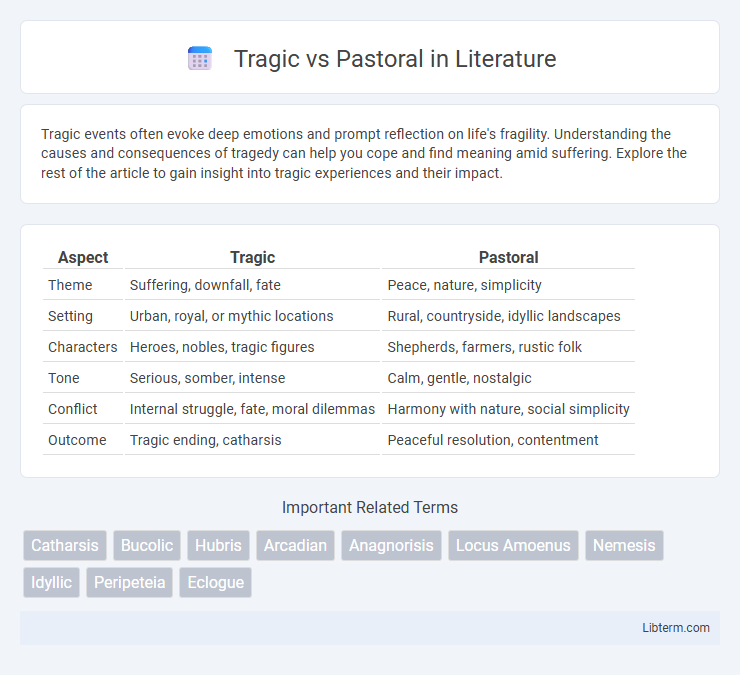Tragic events often evoke deep emotions and prompt reflection on life's fragility. Understanding the causes and consequences of tragedy can help you cope and find meaning amid suffering. Explore the rest of the article to gain insight into tragic experiences and their impact.
Table of Comparison
| Aspect | Tragic | Pastoral |
|---|---|---|
| Theme | Suffering, downfall, fate | Peace, nature, simplicity |
| Setting | Urban, royal, or mythic locations | Rural, countryside, idyllic landscapes |
| Characters | Heroes, nobles, tragic figures | Shepherds, farmers, rustic folk |
| Tone | Serious, somber, intense | Calm, gentle, nostalgic |
| Conflict | Internal struggle, fate, moral dilemmas | Harmony with nature, social simplicity |
| Outcome | Tragic ending, catharsis | Peaceful resolution, contentment |
Understanding Tragic and Pastoral Themes
Tragic and pastoral themes explore contrasting human experiences: tragedy centers on suffering, loss, and the darker aspects of fate, while pastoral themes idealize rural life, harmony, and nature's simplicity. Tragic works often emphasize inevitable downfall and moral conflict, revealing the complexity of human emotions and existential dilemmas. Pastoral literature highlights escapism and a nostalgic longing for innocence, presenting a serene and bucolic landscape as a refuge from societal turmoil.
Historical Origins of Tragic and Pastoral Genres
The tragic genre originated in ancient Greece, with roots in Dionysian rituals and early dramatic competitions, notably evolving through the works of playwrights like Aeschylus, Sophocles, and Euripides. In contrast, the pastoral genre emerged during the Renaissance as a literary response idealizing rural life and nature, drawing inspiration from classical poets such as Theocritus and Virgil. Historical development of tragedy emphasized human suffering and moral dilemmas, whereas pastoral literature celebrated simplicity, harmony, and escapism.
Core Characteristics of Tragic Narratives
Tragic narratives center on human suffering, inevitable downfall, and moral dilemmas that highlight the protagonist's flaws or fate. These stories often involve complex characters facing irreversible consequences, eliciting pity and fear from the audience. In contrast to pastoral themes, tragedy emphasizes conflict, loss, and existential challenges rather than idyllic rural life or harmony with nature.
Defining Features of Pastoral Literature
Pastoral literature centers on idealized rural settings, portraying shepherds and nature as symbols of simplicity and harmony, contrasting with the complexity and suffering found in tragic works. It emphasizes themes of innocence, peace, and the beauty of the countryside, often using poetic language to evoke tranquility and escape from urban life. This genre frequently explores the relationship between humans and nature, celebrating pastoral life as a means to reflect on social and philosophical ideals.
Symbolism in Tragic vs Pastoral Works
Symbolism in tragic works often embodies themes of fate, suffering, and inevitable downfall, using motifs like dark shadows, storms, and broken mirrors to reflect human despair and internal conflict. Pastoral symbolism, conversely, highlights nature, renewal, and simplicity, employing imagery such as green meadows, flowing rivers, and peaceful shepherds to evoke harmony and idealized rural life. These contrasting symbolisms serve to deepen the emotional impact and thematic exploration unique to each genre.
Emotional Impact: Tragedy vs Pastoral Calm
Tragic narratives evoke intense emotions like sorrow and despair through themes of conflict, loss, and human suffering, often leading to catharsis. In contrast, pastoral works emphasize tranquility, harmony, and the beauty of nature, fostering a sense of peace and relaxation. The emotional impact of tragedy stirs deep reflection and emotional release, while pastoral calm soothes the mind and nurtures a gentle, restorative experience.
Landscape Descriptions in Tragic and Pastoral Settings
Landscape descriptions in tragic settings often emphasize harsh, barren, or tumultuous environments, reflecting internal conflict and despair. In contrast, pastoral landscapes are idyllic and serene, featuring lush meadows, gentle rivers, and harmonious natural elements that symbolize peace and innocence. The stark difference in environmental imagery underscores the emotional tone and thematic focus of each genre.
Human Struggle and Fate: Tragic Stories
Tragic stories emphasize the inescapable human struggle against fate, where protagonists confront overwhelming forces or flaws that lead to inevitable downfall. These narratives often highlight internal conflicts, moral dilemmas, and the harsh realities of life, underscoring the fragility of human existence. The tragic genre explores themes of suffering, loss, and destiny, portraying a somber reflection on the limitations imposed by fate and character.
Idealized Nature in Pastoral Writing
Pastoral writing idealizes nature as a serene and harmonious refuge, often contrasting with the chaos and complexity found in tragic narratives. This genre portrays rural landscapes as idyllic settings where simplicity and purity prevail, reinforcing an escape from urban or corrupt realities. The idealized nature in pastoral works serves as a symbolic space for innocence, peace, and the celebration of life's natural rhythms.
Contemporary Relevance of Tragic and Pastoral Motifs
Tragic and pastoral motifs maintain contemporary relevance by reflecting deep human experiences and societal contrasts; tragic themes explore existential struggles and moral dilemmas, resonating with modern audiences facing uncertainty and conflict. Pastoral motifs offer a counterpoint through idealized depictions of nature and simplicity, inspiring a longing for escape and tranquility amid urbanization and technological advancement. The interplay between tragic depth and pastoral idealism continues to influence literature, film, and art, providing a nuanced lens for contemporary cultural critique.
Tragic Infographic

 libterm.com
libterm.com